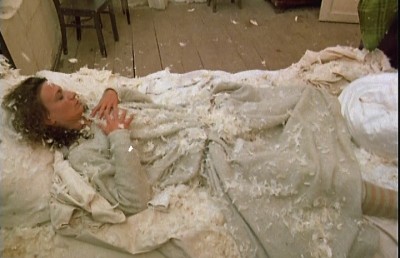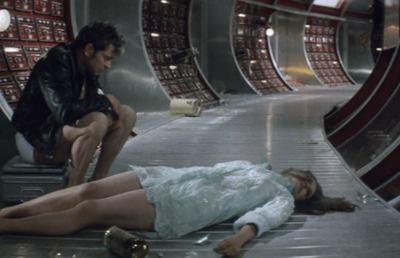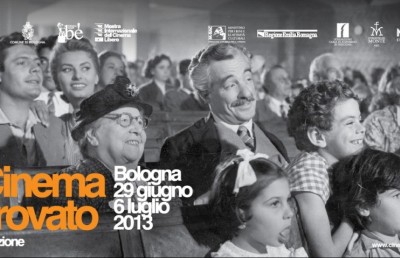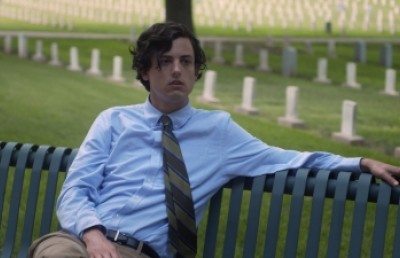Sokurov: An Eye on His Early Masterworks
Cinema Guild Release
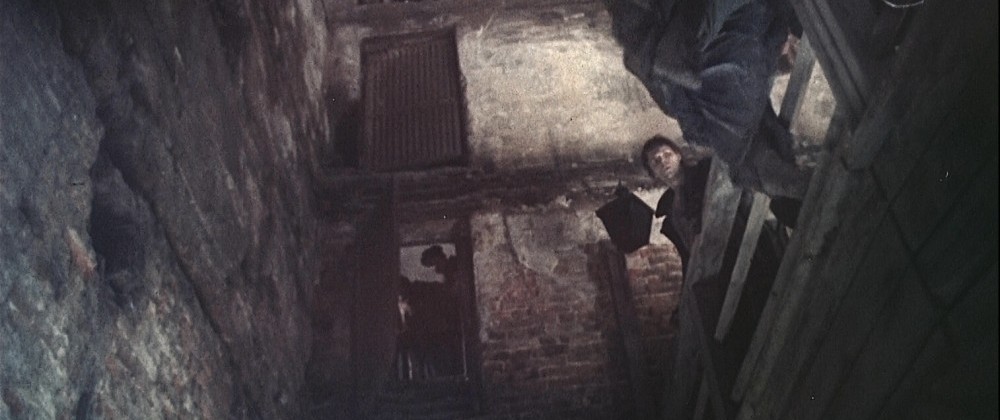

At the age of 54 (the age Tarkovsky died), Sokurov has made over 40 films (shorts and features) and continues to be one of the most avant-garde (a term he detests) filmmakers of his generation, continually shaping technology to his personal vision and remaining true to Tarkovsky’s aesthetic belief that “cinema is a very serious and difficult art, heavy with sacrifice” (quoted from Sokurov’s Moscow Elegy, 1986-88). Perhaps no director has divided his work so equally between fiction and documentary as Sokurov, which makes the Cinema Guild’s recent (December 2012) Sokurov box-set “Sokurov: Early Masterpieces” an excellent reflection of Sokurov’s ‘split’ identity as experimental fiction and non-fiction filmmaker. The Cinema Guild package includes three features, Whispering Pages (1994, the only film featured on Blu Ray, as well as standard definition), Stone (1992), Save and Protect (1989), all featured in their original 4:3 aspect ratio, and five documentaries: Soviet Elegy (1989); An Example of Intonation (1991); Questions About Cinema (2008); Diary of St. Petersburg: Kozintsev’s Flat (1998); and Sonata for Hitler (1979). According to the Cinema Guild, the reason why only Whispering Pages received a high definition transfer onto blu ray is because the source material for the other films was not of a high enough standard to benefit from a high definition make-over. Also included is a 30 minute audio radio program on Anton Chekhov’s house in Yalta, which is the setting for Stone. All in all this is an impressive box set that fills an important gap where the representation of Sokurov on DVD/BD is concerned.
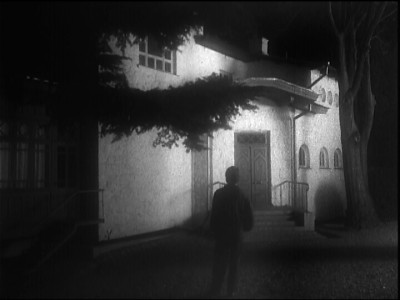
The dream-like opening of Stone
With his impressionistic lighting, lugubrious pacing, intricate mise-en-scène, and sculptural soundscapes, Sokurov can lay claim to being the most formally rigorous filmmaker working today, in either fiction or documentary. But as demonstrated by his groundbreaking “Tetralogy of Power” (Moloch, Lenin, The Sun, Faust), he is forever blurring the lines between fiction, non-fiction, documentary and experimental. Not even the fluid concept of the ‘essay film’ can truly define the place where Sokurov works. In fact, the most ‘avant-garde’ aspect of Sokurov may be the fluidity with which he moves between the typically static categories of documentary, fiction, history, and poetry. In the documentary on Sokurov, included on disk one of the Cinema Guild Sokurov Box Set, Sokurov says, “Fiction and documentary are simply two instruments of a unique and same piece. Two different instruments. One can be finer, the other works more generously….For me it’s of little difference if I make a documentary or a fiction film.”
If there is a constant theme across his body of work it is the study of human solitude and what happens to the human psyche or soul when placed in oppressive or extended isolation. Beginning from the title of his first feature diploma film, Odinokii golos cheloveka (The Solitary Voice of Man, 1978), this is a theme that haunts much of Sokurov’s work, both fiction and non-fiction. The series of “elegy” documentaries suggests this in their title alone. Sokurov ends his documentary on Russian president Boris Yeltsin, Soviet Elegy (contained in this collection), with an uninterrupted eight minute take which begins in long shot and then slowly dollies in to a close-up of Yeltsin seated still in his chair, alone in deep thought, lit by a single overhead kitchen light. In Dni zatmeniia (Days of Eclipse) a young Russian doctor lives in isolation in an arid Central Asian republic (the film was shot in Turkmenistan). In Krug vtoroi (The Second Circle, 1990), a son returns home to stay with his dead father and remains in a perpetual state of stupor while town officials prepare the corpse for burial. In Stone (1992, one of the three fiction features collected in the Cinema Guild’s “Sokurov: Early Masterpieces” box-set) a young guard spends an evening alone in a museum, visited by an older man who may be the incarnation (or the young’s’ subjective imagining) of the great Russian write Anton Checkov. A son spends the final days with his dying mother in an idyllic dacha in Mother and Son. Even his ‘Tetralogy of Power’ series with Hitler (1999’s Moloch), Lenin (2000’s Taurus), the Japanese Emperor Hirohito (2004’s The Sun), and Faust (2011) depict their grand figures as essentially solitary figures (either in the course of history or in their individual life). This sense of human solitude and isolation is perhaps best expressed in his breakthrough film Mat’ i syn (Mother and Son, 1997), a wrenching two-actor chamber piece of sublime beauty and sensitivity; and in the four hour plus poetic retelling of marine life, Povinnost’ (Confession, 1998), which concentrates on the minutiae of marine life isolated from land and people. As in most of Sokurov’s work, thematic elements of loneliness, boredom, ennui, isolation, mourning, grief, or existentialism are imbued in the film’s formal patterns of retardive pacing, long takes, static framing, degraded color, heightened grain elements, ambient sounds and noises, and fog infused lighting.
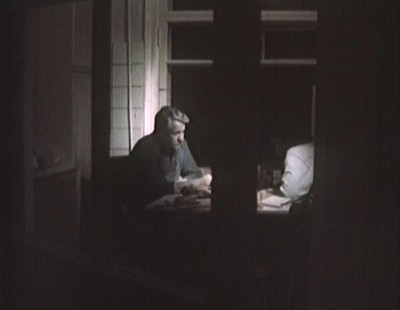
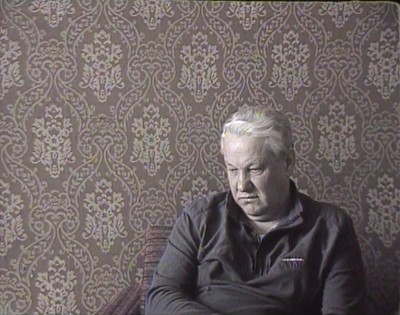
An image of loneliness: Boris Yeltsin in The Soviet Elegy and An Example of Intonation
In the poetic documentary on marine life Povinnost’ (Confession, 1998), the ship’s captain, who sits in solitude writing diary entries, utters a telling line which expresses Sokurov’s indifferent attitude to artistic, social, or political trends: I must continue to “read thick books written by old men.” The captain, with his Romanticist attempts to preserve the grand tradition of classic Russian art and literature (he attempts to memorize all of Anton Chekhov’s work), is a direct descendent to the time-travelling 19th-century French Marquis de Custine from The Russian Ark, 2002. And yet when it comes to questions of style Sokurov is no slave to the archaic, as evidenced by his adoption of digital technology in his one-take ‘temporal float’ The Russian Ark. And for all his aesthetic elitism, Sokurov is just as likely to treat a commoner –a Russian peasant in Maria (Élégie paysanne), a Japanese mountain village woman in A Humble Life??/ ??Une vie humble??– as a famous person –Boris Yeltsin in ??The Soviet Elegy, Alexander Solzhenitsyn in The Dialogues with Solzhenitsyn. If, as Sokurov once said of Stone, “this film will meet with its audience only if the audience searches for it,” the end result of Sokurov’s formally rigorous treatment of thematic isolation and melancholia is the closest you may come in ‘fiction’ cinema to experiencing an aesthetically induced trance state.
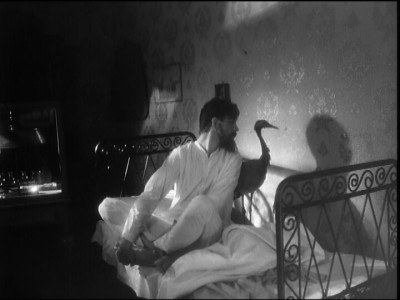
Stone
Which is to say that the Cinema Guild collection is not one you’ll most likely get through in one or two sittings, but more likely split across several screenings, perhaps broken down by subject or genre (like watching all the documentaries and then all the fiction). You will certainly want to watch Stone twice, the second time to benefit from James Quandt’s excellent commentary track, which excels in contextualising the film within Sokurov’s other films (most interestingly the homoeroticism some critics read into his films, and Sokurov abhors, most notably Confessions, Father and Son, and Stone), other directors (Bresson, Tarkovsky, Malick), its painterly allusions (Hans Caspar David Friedrich, El Greco), and Sokurov’s use of classical music. As can be observed by the captured stills above, the Cinema Guild transfer of Stone, a film of great visual texture and sophistication, holds up well to scrutiny with its strong contrast and detail.
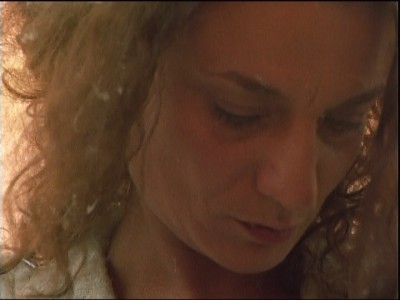
Cécile Zervudacki as Madame Bovary
Save and Protect is chronologically the earliest of the three feature fiction films presented on the Cinema Guild box set and, to my mind, the lesser of the three films (though not a film without interest, especially as a film that fits only stubbornly into an auteurist reading). Since it has received less critical analysis than the other films in this collection I have decided to devote more space to it in my overview of the Cinema Guild Sokurov box-set. As such, it is an odd entry into the Sokurov filmography, a bizarre adaptation of GUSTAVE FLAUBERT’S classic realist novel “Madame Bovary,” published in 1856. The film follows the bare story elements of the novel –a bored petite bourgeois wife, played by a middle-aged, homely looking Cécile Zervudacki, turns to adultery and flurries of spending, which incurs a fatal debt, to escape her provincial prison house– as well as an element of realism, more so in the first half, with the hand-held camera and naturalistic lighting, but adds layers of odd metaphysical rumblings and histrionic styling that don’t fit easily into Sokurov’s visual palette (most notably the frequent and ultimately conventional use of wide angle lens and zoom shots).
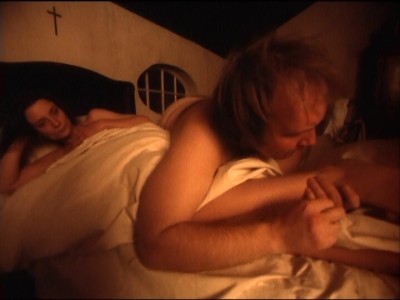
Wide angle distortion in Save and Protect
Admittedly, Save and Protect is the only Sokurov film that I have reacted to negatively. On my first viewing of the film several years ago I had the sense of a miscalculated piece of neo-psychological/metaphysical experience. Sokurov has always incorporated the carnal into his works (as James Quandt notes in his commentary to Stone). I imagine Save and Protect was Sokurov’s attempt to show the rift between the pleasures of the body and the loftier goals of the soul. However, the film is heavily weighted on the former side (Emma has sex in rooms, meadows, coaches, anywhere she can), with little contemplation of how the soul manifests itself in this conflict; and bereft of the usual opaque formal minimalism that Sokurov uses to suggest spiritual trance states. These initial feelings were in response to the original 168 minute version, seen many years ago, however the version presented in this Cinema Guild box-set is Sokurov’s 2009 re-edited cut of 128 minutes. This still remains my least favorite Sokurov film, but viewing the shortened version increased my appreciation for the film. The shorter version feels tighter with Cécile Zervudacki’s performance as the disturbed heroine Emma taking a more central force. There is still a preponderance of uninteresting (and certainly not erotic, which is intentional) sex scenes, but the shorter version gains by focussing the film’s energies on the tragic heroine Emma’s slow descent into a bourgeois, boredom-induced psycho-sexual hell. Sokurov himself has said in the contained documentary Questions of Cinema that his aesthetic aim is to go for atmosphere over action, but Save and Protect falls too often on the side of action (of the sexual variety) over mood and atmosphere (of which there is some, notably in the exterior scenes of landscape and the oddly compelling concluding funeral march). The shortened version also better underscores how Sokurov blurs the line between sex and death by echoing the many shots of Emma lying supine while having sex, with later shots of Emma’s supine corpse –which explains her often passive state during sex, which are echoed in the later (in one case frankly disturbing) images of Emma lying in her death state. And Sokurov stages most of the sex scenes in cloistered and claustrophobic settings, with a hint of morbidity already present.
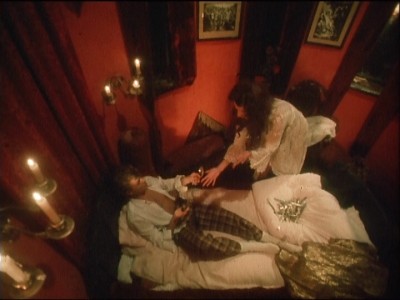
Sokurov’s camera in Save and Protect, especially the first half, is more verite than it has ever been, employing a long take, hand-held shooting style and naturalistic lighting, removed from the more controlled long take style of Stone and Whispering Pages. Also new to Sokoruv’s stylistic palette is the use of quick zoom shots, like the one that zooms from outside her open window into a close-up of her mouth as she screams in response to a lover’s farewell. The one formal area where the film remains pure Sokurov is the disarming soundscape, where natural synchronous sounds (source seen) vie for our auditory attention with asynchronous sounds (unseen source), alien sounds, dialogue, wind noises, bells, train noises, buzzing flies and bird whistles. Adding to the sense of temporal oddity is the interjection of anachronistic elements (a man wearing a contemporary wrist watch, cars entering the frame during the funeral march). But the film does feature some strikingly composed, painterly like frames which cry to be read as gestural touches. Like the shot which suggests the female nude of classical oil painting in the way the nude Emma is framed caressing a flower on the right side of the frame, balanced by a vase, and a gilded bird cage (symbol of her social imprisonment?) on the sill of an open window looking out onto a craggy mountainscape. From the scene above comes an unusual moment of voyeuristic intimacy which foreshadows Mother and Son. The nude Emma walks over to the bed and picks up her nude daughter who we assume was sleeping next to her. She then cradles her in her arms: a gesture which foreshadows the gesture with the son carrying his mother in the later Mother and Son The hand-held style gives way to more stolid framing as Emma descends further into madness, the static framing another indicator of her entrapment. One of the best such scenes has Emma dressed in black with a witch-like cape visit one of her lovers at his foundry to ask for money to help pay her debt. The long take shot is lit in a sombre brownish-red light. Framed in a diagonal long shot between her lover and a huge foundry machine, Emma’s hysterical ranting is played out against the rhythmically grinding sound of the huge foundry machine. In the next scene, debt unpaid, Emma swallows arsenic and then returns to die in her bedroom, which now appears to be roofless, allowing gusts of wind to blow debris and fluff into the room.
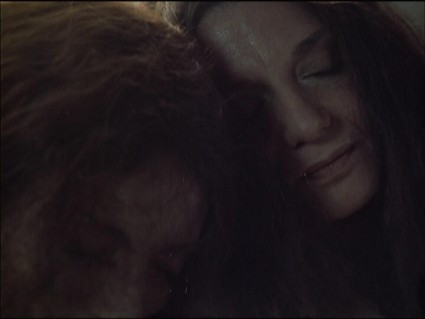
Enigmatic ending to Save and Protect
Her death is followed by the film’s haunting conclusion. Her body is placed, Chinese doll-style, in three coffins, an oak coffin, placed into a mahogany coffin, placed into a huge metal coffin. The oversized coffin is accompanied by members of the community to its burial ground. The coffin is lowered into its final resting spot and Emma’s daughter places flowers at the head of the coffin. The ten minute scene is played with natural sounds and choral music. The scene then cuts to an enigmatic final scene. The choral music bridges the next shot, which begins on a blank wall and slowly pans left to reveal Emma, blank faced, but alive, muttering unheard words. The camera stops, as Emma’s eyes look skyward; a second woman who looks very much like Emma, enters the frame from the left and rests her head against Emma’s shoulder. Her eyes are shut. Emma also shuts her eyes to form an expression of contentment. The image freeze frames, and then fades to black. How are we to read this scene? Is it a posthumous coda, like the end of Tarkovsky’s Ivan’s Childhood ? Is the second woman Emma’s “double,” her soul mate? Or perhaps even her soul?
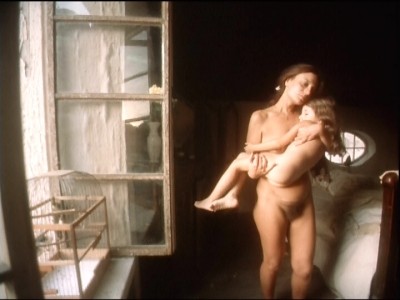
With regards the quality of the transfer, Save and Protect, presented (correctly) in a 4:3 aspect ratio, has a more than acceptable image quality, but remains the least attractive of the three feature films, with the high definition version of Whispering Pages expectedly trumping everything in the collection with its impressive bit rate rendering the film’s celluloid grain and texture admirably. Save and Protect has an earthy, dirt-like palette which is no doubt intended by Sokurov to depict Emma’s own drab, weathered wardrobe and her highly sexualized behaviour and is also a by-product of being shot on the desert locations of one of the southern outlying republics of Russia (which likens it visually in its exteriors to Sokurov’s haunting masterpiece, Days of the Eclipse). The print is comparable (if not from an identical source) to the Artificial Eye Pal DVD release from 2012. Like the latter, it does show the few odd tape splices, dirt and speckles, but is still an acceptable standard definition transfer, and likely the best we’ll ever see this film on home video.
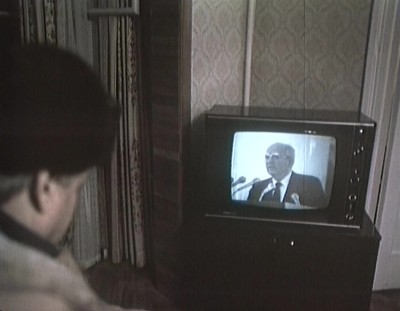
Soviet Elegy
The highpoint of the Cinema Guild box-set is undoubtedly Whispering Pages (1994), Sokurov’s impressionist adaptation of Fyodor Dostoyevsky’s Crime and Punishment, which follows the misfortunes of a young man (Aleksandr Cherednik), perhaps a somnambulist, as he dream-walks through an urban landscape of concrete apartment buildings, arched walkways and labyrinthine corridors. Periodically men harass him physically for no apparent reason. In one bizarre scene the lead character, filmed in a low angle staring from the bottom of an abyss-like landing, looks on as people, filmed in slow motion, jump over a railing or from open doors to their apparent death. Odd angles, lenticular distortion and strange perspective create a surreal Escherian space. The film is the equivalent of a sensorial muted experience. The palette and texture alone create a sense of unease, disquiet, calm, with sandy, grainy color, alternating between colorish and black & white and brown; temporal estrangement is invoked through spatial distortion, with objects that appear slightly distorted, elongated, as if somehow filmed reflected off a concave mirror (most likely with a special tilting lens that skews straight lines). A similar spatial distortion occurs in Stone, Mother and Son, and many other Sokurov features. Sound too is opaque, whispered, awash in layered textures of water, low audible classical music, human voice, incidental sounds. Sokurov abandons the lead character for minutes at a time, preferring to focus his camera on a wind storm, a tranquil ocean or a nearby forest.
Nature takes precedence also in the two documentaries on Boris Yeltsin, Soviet Elegy, 1989, which was shot just a few years before Yeltsin would become the first President of the Russian Federation, serving from 1991-1999, and An Example of Intonation, made shortly after he took power. Soviet Elegy opens with contemplative tracking and panning shots along the grounds of a cemetery on an overcast, autumnal day. The camera stops to take in the names of the deceased on the headstones. Recalling Tarkovsky, a cuckoo bird is heard while the camera tracks quickly along rows and rows of gravesites, with apartment blocks visible in the far background. Finally, eight minutes into the film we see Boris Yeltsin walking along the corridors of a government building (perhaps the ones seen in the background earlier). At this point the film begins a more conventional biographical history of Yeltsin (1931-2007), but is interrupted by a peculiar 10 minute montage of close-up photographs of prominent Soviet political figures. After the montage we get an interesting shot of Yeltsin sitting stoically watching Gorbachev on television (Gorbachev and Yeltsin had more than their series of political battles).
Echoing the opening of Soviet Elegy, An Example of Intonation, filmed in color on video, opens with a five minute slow paced montage of static camera shots of a sunny, wintry forest, before cutting to a long, hand-held shot following Yeltsin walking with filmmaker Sokurov (here invoking the old Socialist notion of the artist as worker) through the same wintry setting. A portion of the film is Sokurov and Yeltsin sitting on a park bench talking about Russian political life. A slow dolly out from Yelstin sitting alone against patterned wall-paper dissolves to an extract of a repeat of the final shot from Soviet Elegy, discussed above, which then dissolves to the new footage against the wall-paper, a contrast between the present and recent past. The film has little value from a cinematic standpoint but holds merit from the purely historical vantage of seeing such an important political figure speaking informally and frankly about a range of issues (chastising someone in his household for asking for ketchup!); inviting Sokurov to a very relaxed dinner with his family. The film ends with a protracted driving sequence following Yelstin’s security car.
Questions About Cinema (2008) is a documentary about Sokurov made for French TV. It is interesting in so much as we hear Sokurov talk freely about a range of personal and historical subjects that are close to his heart. Much of the documentary has Sokurov as his own talking subject responding to a broad range of issues which touch his cinema, art, the military, music, Russia, the second World War, fatherhood, and the intersection of art, spirit and religion. One of the intriguing things we learn is how highly he values sound above the image because it is something more spontaneous, creative and less tied to human creation (he states “sound is the soul, image the legs”); and how he still feels that ultimately cinema is a lesser art, because it has less freedom, than painting and music; and how he feels a kinship with classic pre-20th century art and little for anything post 20th century. And while Sokurov’s aesthetic ideology is conservative, his practice is very experimental and avant-garde (a conservative modernist, as James Quandt calls him). The film also features well over a dozen clips from his films, featuring most of his key works usually edited to coincide with what Sokurov is saying. For example, speaking from a biographical reality of being the son of a military father, Sokurov states baldly that military people are the weakest people in the world. This passage cuts to shots of young soldiers from Spiritual Voices. This biographical knowledge helps explains his interest in military life seen in Spiritual Voices, Confessions, and Alexandra (which is also released by Cinema Guild) and his power tetralogy. It is fascinating to see Sokurov speak so fervently about the need for a personally committed cinema that speaks above all else to an individual’s inner self. Toward the end, over images from Lenfilm Studios he gives advice to young filmmakers, telling them they need to select four or five ideas and let those ideas nurture within them over years to the point where, hopefully, they will be your ideas.
For those who think of Sokurov mainly as a contemplative, long take stylist, his found footage short compiled of German and Russian archival footage from the end of World War 2, Sonata for Hitler, will surprise with its impressive rhythmic, intellectual and vertical (sound/image juxtaposition) editing, a montage piece so expressive that it recalls the great montage period of the 1920s (Vertov, Eisenstein, Pudovkin). In this respect this was, for this viewer, the revelation of the box-set.
The Diary of St. Petersburg: Kozintsev’s Flat (SD, 48:36), Sokurov’s homage to filmmaker Grigori Mikhaylovich Kozintsev, is the least interesting film in the collection. For the majority of the film Sokurov slowly traces every nook and cranny of the apartment once inhabited by Kozintsev and his family with slow pans and tracking shots. There are only a few film extracts (from King Lear) but instead audio extracts of sound bites, diary extracts. We are relieved when the scene cuts to shots of the ocean, rippling water and light recalling the Impressionist painters of the pre-cinema era.
The Cinema Guild must be congratulated for putting together one of the BD/DVD highlights of 2012. To think that the filmography of one of the more esoteric and difficult of contemporary directors working today is so well represented on DVD (and now BD) is as gratifying as it is surprising. The disks come packaged in an attractive earthy brown (Sokurovian no doubt) box containing an inner sleeve which folds opens to the three disks and the fourth far left flap adorned with an image from Whispering Pages. For a breakdown of the DVD/BD content please see below:
DISC ONE – WHISPERING PAGES (Blu-ray, 1994, 70 minutes))
o AN EXAMPLE OF INTONATION (1991, 48 minutes)
o SOVIET ELEGY (1992, 68 minutes)
o QUESTIONS ABOUT CINEMA, a documentary on Alexander Sokurov (2008, 60 minutes)
DISC TWO – STONE??* (??Kamen, DVD, 1992, 73 minutes)
o Audio commentary by film scholar James Quandt *
o DIARY OF ST. PETERSBURG: KOZINTSEV’S FLAT (1998, 48 minutes)
o “The House That Chekhov Built,” a BBC audio program on Anton Chekhov’s house in Yalta, the setting for STONE (30 minutes)
o SONATA FOR HITLER (1979-1989, 10 minutes)
DISC THREE – SAVE AND PROTECT (DVD, 1989, 128 minutes)
o SD copy of WHISPERING PAGES (1994, 70 minutes)



